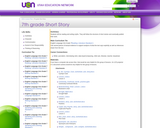
Students will be reading and writing myths. They will follow the structure of short stories and eventually publish their work.
- Subject:
- Fine Arts
- Material Type:
- Lesson Plan
- Unit of Study
- Provider:
- Utah Education Network
- Date Added:
- 11/01/2017

Students will be reading and writing myths. They will follow the structure of short stories and eventually publish their work.
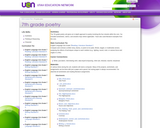
The 7th grade poetry unit gives an in depth approach to poetry involving the four strands within the core. I've included worksheets, rubrics, and answers keys where applicable. I have also used literature examples from the core.
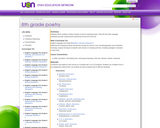
Students will be creating a variety of poetry as well as analyzing poetry. They will work with Language standards and take a performance assessment at the end of the unit.
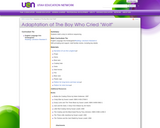
This activity focuses on retelling and performing a story that has been formatted from a traditional version to the setting of the Old West. When retelling a story to someone else, it is important to have the sequence and all parts to the story in correct order. The beginning of a story generally tells who the characters in the story are and what the problems may be. The middle generally explains what attempts were made to solve the problems, and the end generally has the solution, results, and how the story ends. For this activity, students should be familiar with the original tale so they will see the parallel between the original and the adapted version. As you are preparing to retell/role-play the story, you will need to discuss the main characters the students will be portraying and decide what simple props, if any, may be helpful in telling the story.
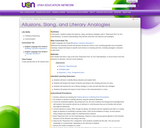
In this lesson, students analyze the allusions, slang, and literary analogies used in "Raymond's Run" by Toni Cade Bambara. To extend understanding, they will then write their own allusions and analogies.
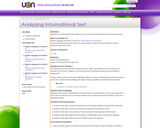
In this lesson students use the Informational Text Analysis Tool to deconstruct the essential elements of informational text. Informational text is more important to teachers than ever before, especially with the rise of the new Core standards. The Library of Congress is an excellent resource for finding and using texts to build students' reading skills.Through a diverse array of classic and contemporary literature as well as challenging informational and primary source texts, students build knowledge, gain insights, explore possibilities, and broaden their perspective.
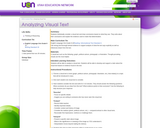
In this lesson Students individually consider a visual text and draw conclusions based on what they see. They write about their conclusions and explain the evidence used to make that determination. Students will be able to analyze a visual text. Students will be able to develop and support a claim about the visual text based on evidence found in the text.
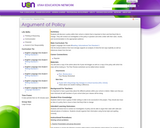
Students will discover a policy within their school or district that is important to them and that they'd like to change. They will conduct an investigation of the policy in question and write a letter with their claim, results, and recommendation to the appropriate audience.

In this lesson, students will have an opportunity to apply their understanding of rate and ratio. They will analyze the fees of different campgrounds and use that information to make decisions about where to camp. Students will be able to use ratio and rate reasoning to solve real-world and mathematical problems by using tables to organize equivalent ratios.

This lesson will involve work in oral language, concepts of print, spelling, fluency, vocabulary, comprehension, and writing with the use of one book, The Black Snowman.

In this set of lessons which extend over several days, students read excerpts from "The Death of Benny Paret" by Norman Mailer and "The Fight" by William Hazlitt. Students annotate the text, specifically looking for metaphor and simile, tone, and syntax. Working with a partner, students write three paragraphs, analyzing metaphor or simile, tone, and syntax in "The Death of Benny Paret." Working independently, students write one paragraph, choosing to analyze metaphor or simile, tone, or syntax in "The Fight."
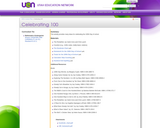
This activity provides many ideas for celebrating the 100th Day of school.
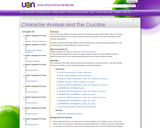
This set of lessons extends over several weeks and incorporates all acts of Arthur Miller's play, The Crucible. Students will closely read The Crucible. Students will cite textual evidence and make interpretations about character development. Students will combine the textual evidence with their interpretations and write interpretive statements. In the culminating activity, students will write a character analysis.
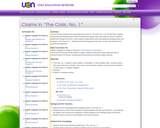
This set of lessons extends over several days and focuses on "The Crisis, No. 1" by Thomas Paine. Students closely read and annotate the text. Students identify and evaluate claims and evidence in the text. Students present their findings to the class. Finally, students collaboratively write short arguments identifying claims and evidence in "The Crisis, No. 1." Students present their arguments to the class, and the class discusses and assesses the arguments.

This set of lessons extends over several days. Students watch a Prezi and take notes about the classical appeals (ethos, pathos, and logos). Students then read and annotate (focusing on the classical appeals) Winston Churchill's "Be Ye Men of Valour" and Franklin Delano Roosevelt's "Pearl Harbor Address to the Nation." Students work in groups to complete a graphic organizer which helps them analyze the classical appeals in the speeches. Finally, students write an analysis of ethos, pathos, and logos in one of the speeches.
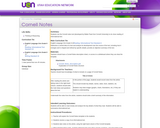
In this lesson Students use the Cornell notes tool (developed by Walter Pauk from Cornell University) to do close reading of informational text. Students will be able to read closely and analyze the key details of what they read. Students will be able to summarize informational text.
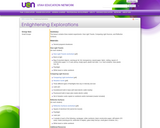
This lesson contains three student experiments: How Light Travels, Comparing Light Sources, and Reflective Surfaces.
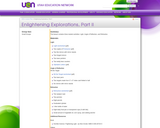
This lesson contains three student activities: Light, Angle of Reflection, and Refraction.
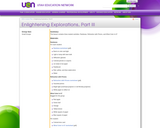
This lesson contains three student activities: Rainbows, Refraction with Prisms, and What Color Is It?
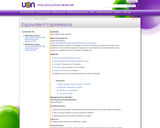
Lesson focuses on creating equivalent expressions. Isolating the variable.
Focus Questions:
What value of the variable will create two equivalent expressions? How can this solution be checked?How can inverse operations be used to isolate the variable?What operation(s) will be needed to isolate the variable?
Lesson Segment 1: Accessing Background knowledge, Launch-Finding Equivalent Expressions.
Lesson segment 2: What value of the variable will create two equivalent expressions? How can this solution be checked?
Lesson Segment 3: How can inverse operations be used to isolate the variable?
Lesson Segment 4: Summarize
Assessment Plan:observation, questioning, performance